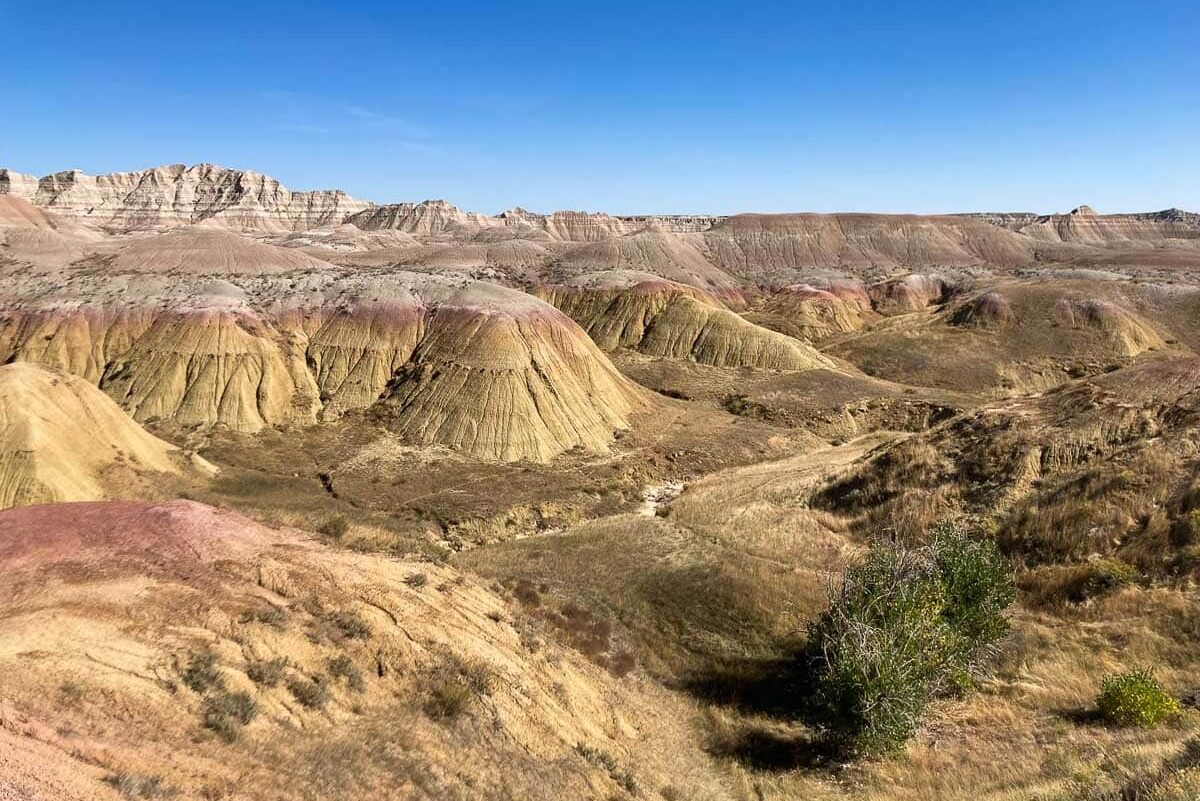19 Essential Things to Do in Badlands National Park
In the rolling prairie of southwestern South Dakota lies Badlands National Park, home to a magnificent collection of colorful buttes, hills, pinnacles and spires.
There are many ways to explore and experience this otherworldly landscape of badlands and prairie, from scenic drives and ranger walks to backpacking adventures.
In this post, you’ll find the best things to do in Badlands National Park, all of which can be accomplished in just a day or two.
This blog post about the best things to do in Badlands National Park contains affiliate links. You can read more about our Terms of Use / Disclosure here.
Top Things to Do in Badlands National Park
Badlands National Park is one of my favorite U.S. national parks for more reasons than one. It’s quite a remote park, but once you get there, it’s also exceptionally easy to explore.
Simply driving the scenic Badlands Loop Road will bring you to most of the highlights of Badlands National Park, including viewpoints, trails and other places of interest.
On top of that, you’re also guaranteed to see some wildlife in Badlands, which is home to American bison, pronghorn, prairie dogs, rattlesnakes, bighorn sheep and coyotes, among innumerable other species.
Visit the visitor center, watch a sunrise or sunset, go for some short hikes, view wildlife, explore wilderness areas,… There are so many fun things to see and do in Badlands National Park. Let’s take a closer look at them below.
1. Visit the Ben Reifel Visitor Center

When visiting a new national park, I always swing by the visitor center first. And I strongly recommend doing this to anyone. Visitor centers are the single best resource for park information, current conditions, activity suggestions and so much more.
In Badlands National Park, the Ben Reifel Visitor Center at Cedar Pass has a wealth of information. You can talk to rangers, see the museum exhibits, watch the park movie, browse the bookstore and visit the (seasonal) Fossil Preparation Lab.
2. Drive the Badlands Loop Road
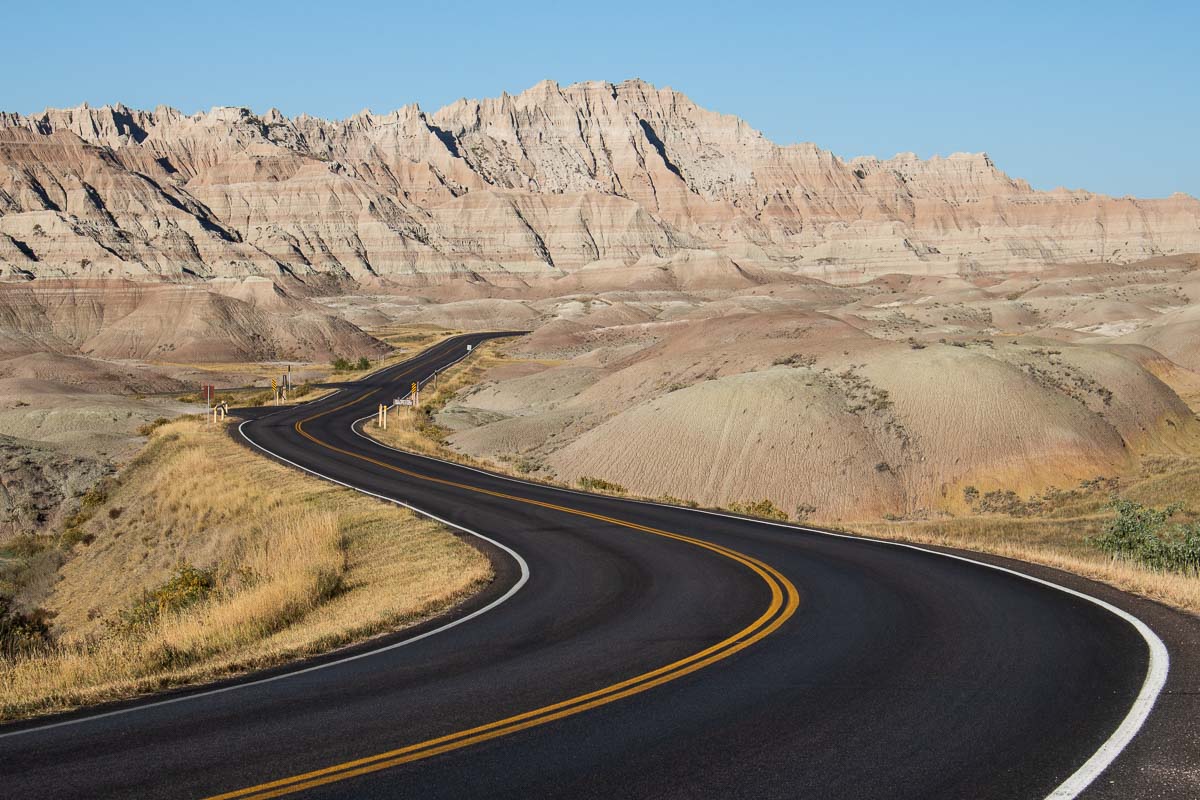

Thanks to the scenic 30-mile Badlands Loop Road, you can easily get to most of the top attractions in Badlands National Park, while enjoying some truly superb scenery along the way.
The only fully paved road through the park, it is lined with spectacular overlooks, trailheads and historic sites. Many of the top things to do in Badlands National Park are on or just off of the Badlands Loop Road.
Officially known as Highway 240, the Badlands Loop Road runs through the heart of the park’s North Unit.
This is where you’ll find main attractions like the Ben Reifel Visitor Center, picnic areas and popular viewpoints like the Big Badlands Overlook, Panorama Point, the Yellow Mounds and Pinnacles Overlook, among numerous others.
Additionally, essentially all major hiking trails in Badlands National Park start on the Loop Road.
3. Wake Up Early for a Badlands Sunrise


While the harsh overhead sunshine of midday hides the delicate colors of the Badlands, the soft morning light brings out a spectrum of gorgeous pastel shades.
At sunrise, when the sun first peeks above the horizon and casts its rays across these rugged ravines and razor-edged ridgelines, the Badlands display a range of pale purples, subtle pinks and light oranges.
Dawn also comes with dramatic shadows in the Badlands, creating an incredible three-dimensional landscape.
Enjoying the sunrise in Badlands National Park is easily one of the top things to do in Badlands National Park. A number of overlooks face east to southeast, providing jaw-dropping views of the sunrise.
These are some of my personal favorite places to see a Badlands sunrise:
- Big Badlands Overlook
- Door Trail
- Window Trail
- Panorama Point
- Burns Basin Overlook
Read more about these Badlands National Park sunrise spots here.
4. Stay Out Late for a Badlands Sunset


Just like sunrises provide memorable moments of magic in Badlands National Park, sunsets do, too. As the sun slowly drops toward and then below the horizon, the colors of the Badlands undergo a dramatic, mesmerizing shift.
Grays grow purple, whites turn into pink, browns become orange. It’s a magnificent sight to see, especially when taking in the landscape from a panoramic overlook.
My recommended locations to catch a sunset in the Badlands are:
- White River Valley Overlook
- Bigfoot Pass Overlook
- Conata Basin Overlook
- Pinnacles Overlook
Read more about these Badlands National Park sunset spots here.
5. Hike the Unforgettable Notch Trail
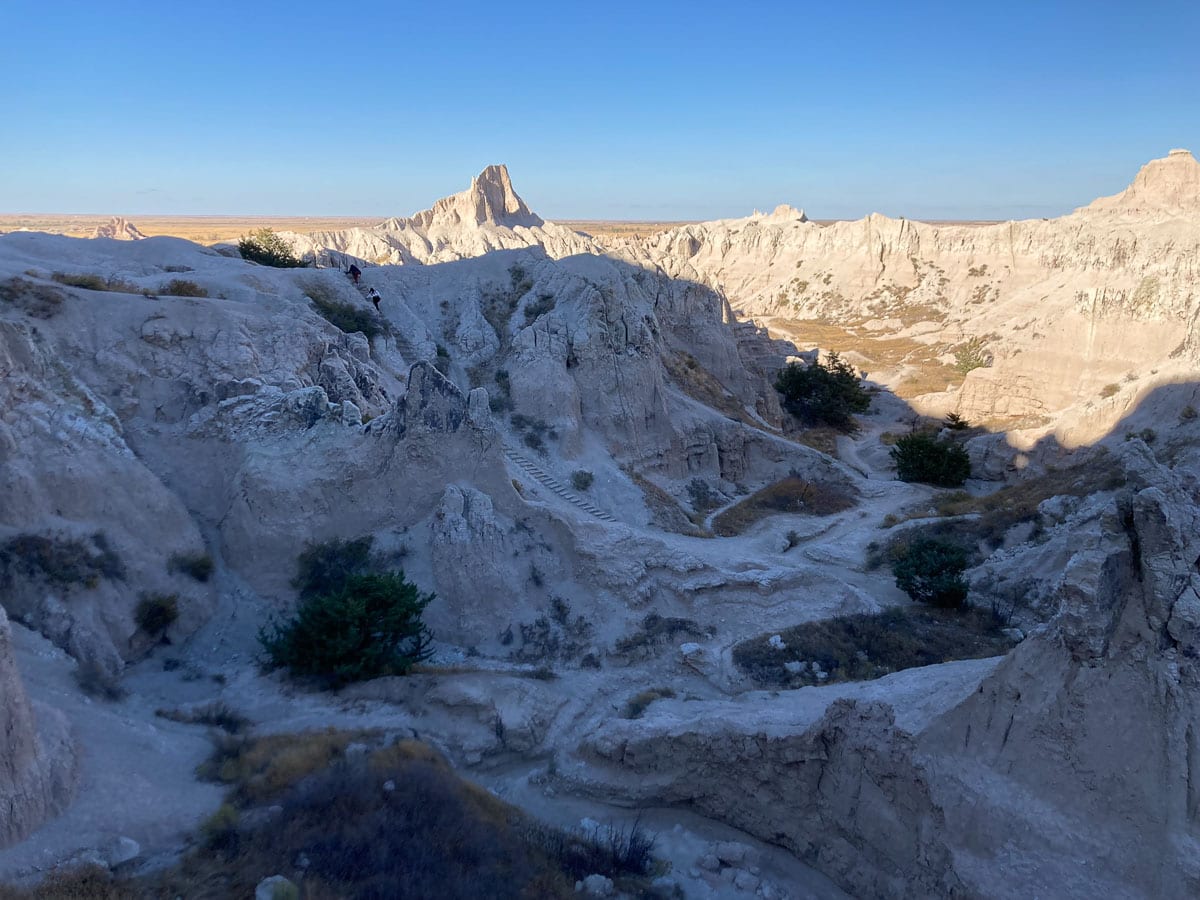
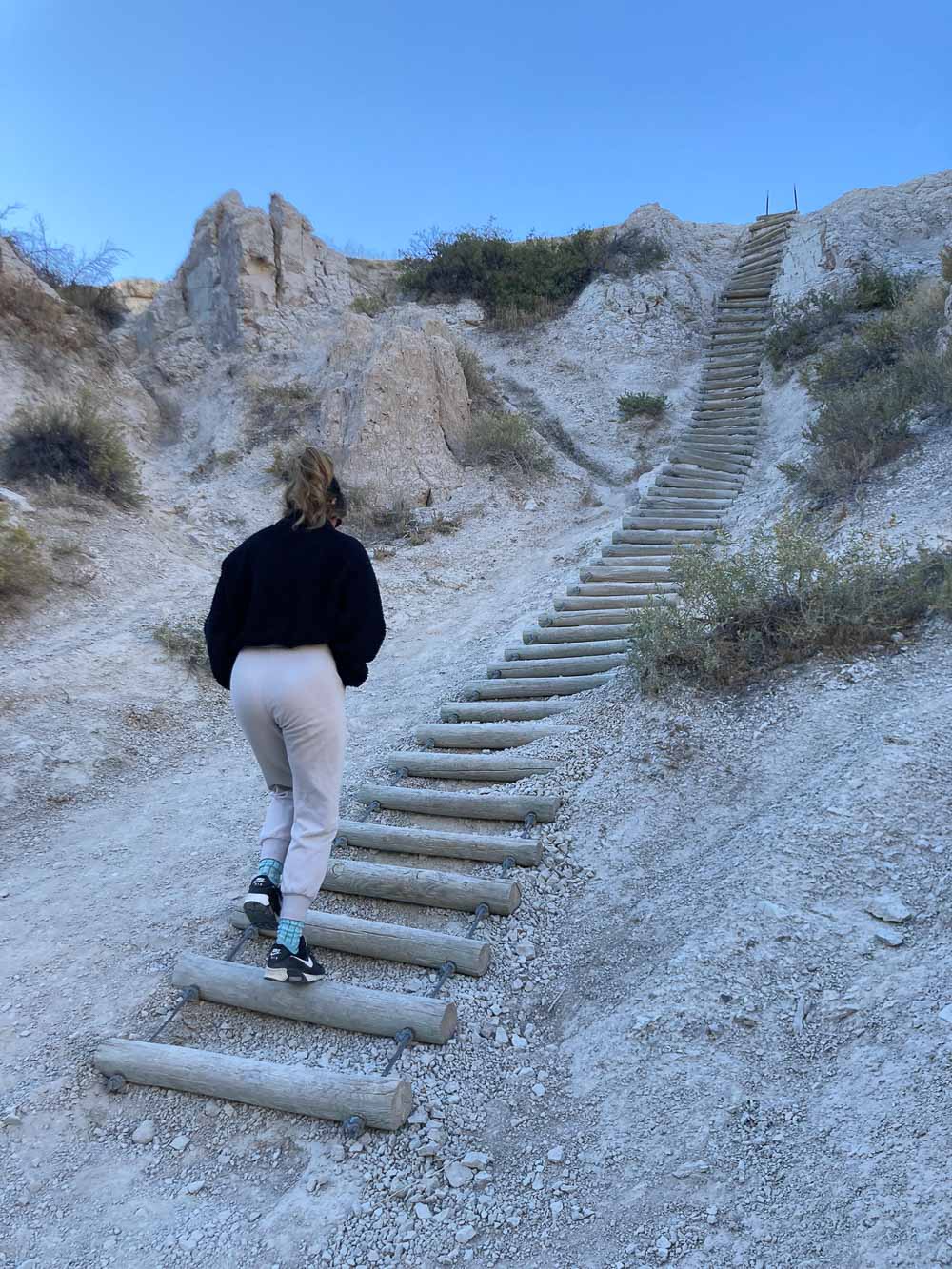
Hiking is without question one of the best things to do in Badlands National Park to really experience this beautiful park. If you have time for only one hike, I couldn’t recommend the Notch Trail more.
Arguably the most popular day hike in Badlands National Park, the 1.5-mile roundtrip Notch Trail combines a fun ladder climb, a walk along a cliff edge and a spectacular view.
The trail starts at the south end of the Door, Window, Notch and Castle Trail parking lot, winding its way briefly through a beautiful canyon, before ascending a log ladder and continuing along a ledge.
The ultimate destination is “the Notch,” where a dramatic, panoramic view of the White River Valley awaits.
This is one of the most fun hikes in Badlands National Park, but the Park Service reminds hikers to be careful on cliff edges. Additionally, the trail is usually quite slippery during and after rainstorms—think twice before doing this hike in those circumstances.
6. Learn About Paleontology on the Fossil Exhibit Trail
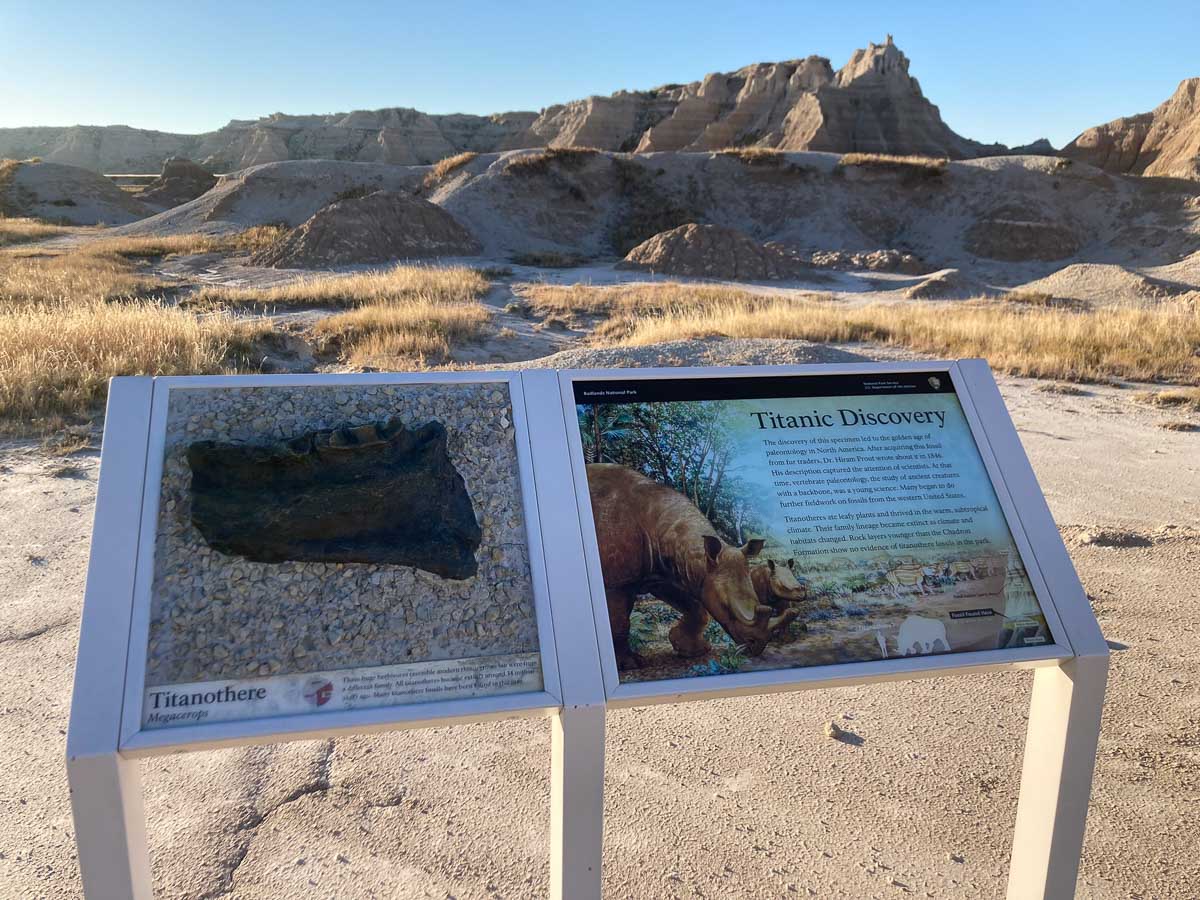

This is one of the Badlands National Park activities you shouldn’t skip. Even if you’re not into paleontology or general history, walking this short boardwalk does give you a better insight into what this national park is about.
As its name suggests, the Fossil Exhibit Trail runs past a number of exhibits of fossil replicas. You can learn about the ancient animals that once lived in this region—the White River Badlands are home to one of the world’s richest mammal fossil beds.
Walk this easy 0.25-mile-long wheelchair-accessible loop trail and learn about extinct animals like sabertoothed cats, the ancestors of modern-day horses and Titanotheres.
Further reading: Best National Parks and Monuments for Dinosaurs and Fossils
7. Immerse Yourself in the Badlands and Prairie on the Castle Trail – Medicine Root Trail Loop
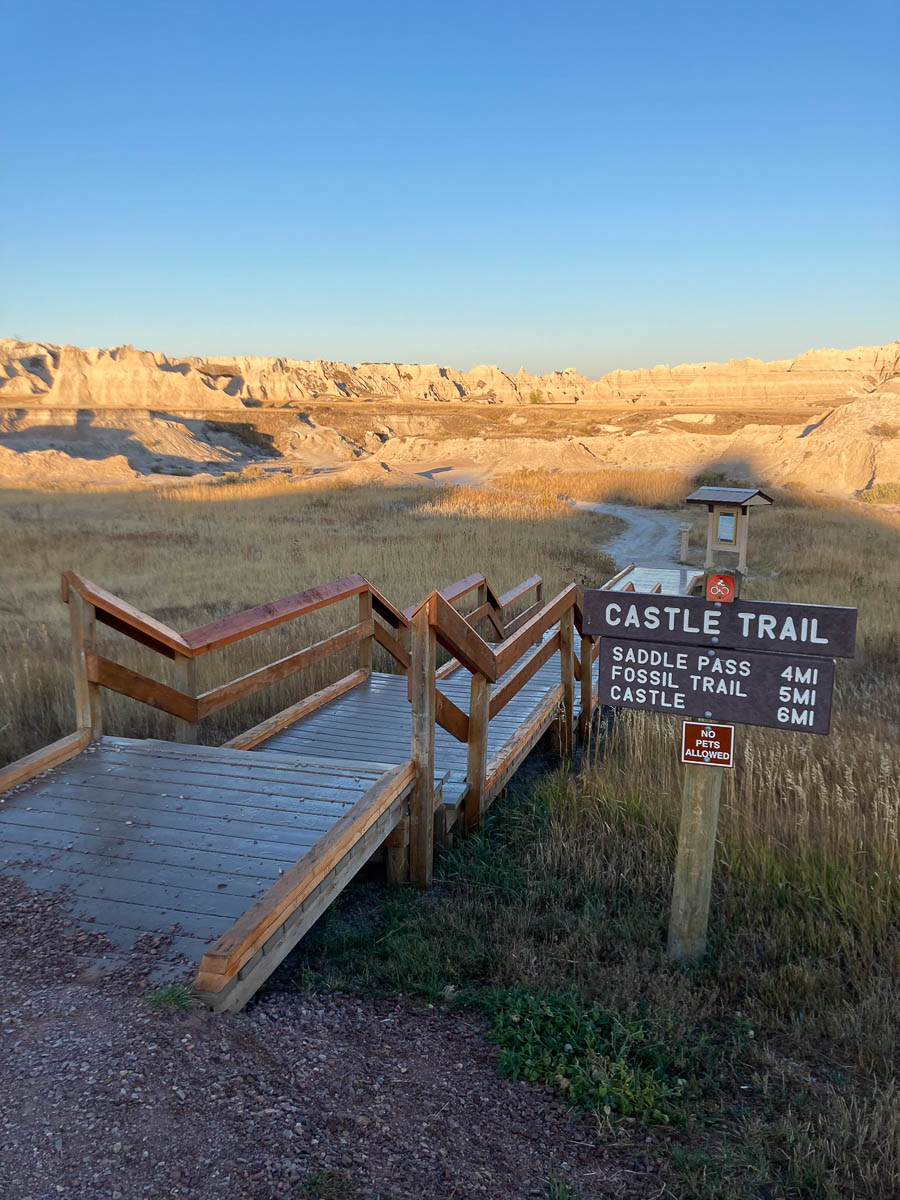

A combination of two of the longest hiking trails in Badlands National Park, the Castle Trail – Medicine Root Trail Loop explores the mixed-grass prairie of the park. It also offers wonderful views of the Badlands formations.
This loop is about 4 miles long, slightly more when taking into account the access trails.
You can get to the loop via the Castle Trail from the Door, Window and Notch Trails parking lot or from the Castle Trailhead at Fossil Exhibit. The Saddle Pass Trail offers the shortest, yet steepest, access path to the loop.
A relatively level and moderate hike, this is a great option for visitors looking for a longer and varied hike in the Badlands.
8. Climb the Badlands Wall to Saddle Pass
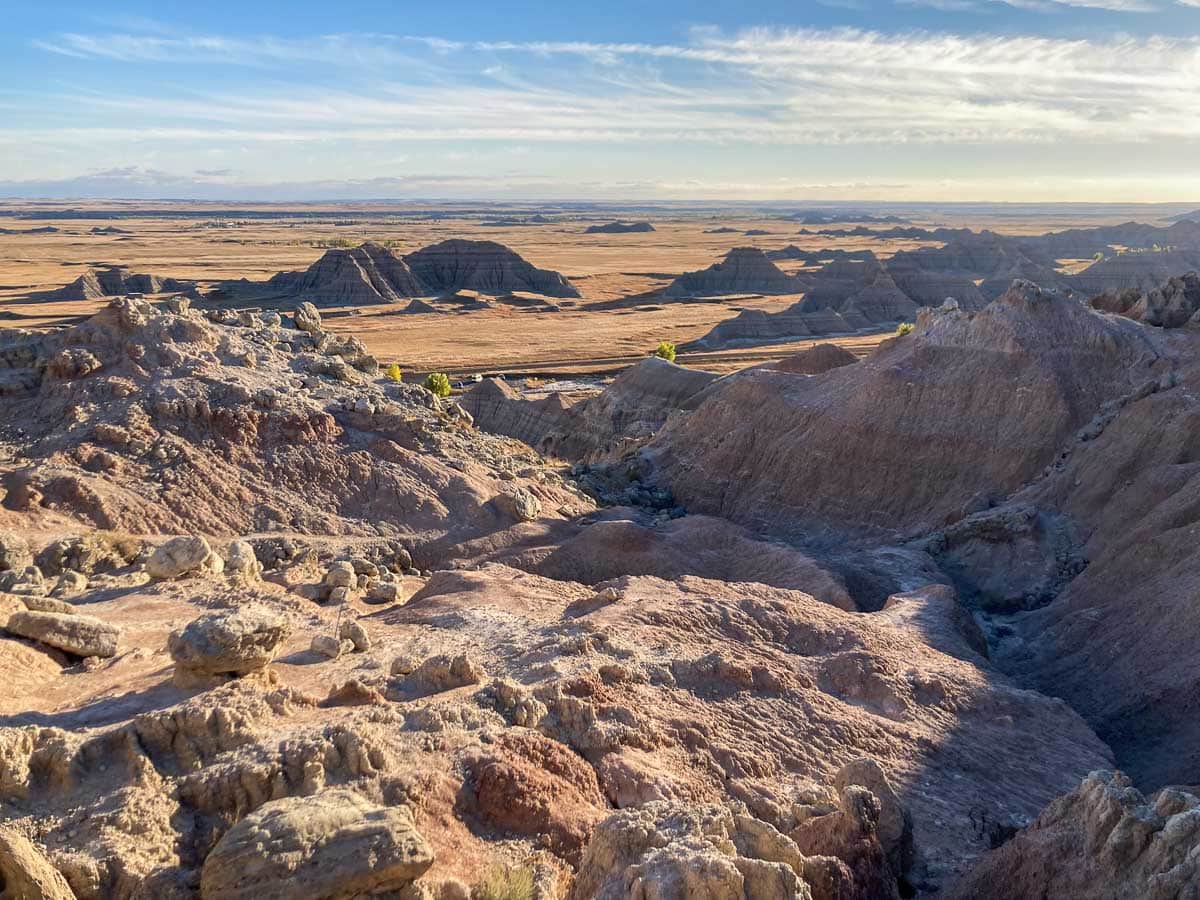
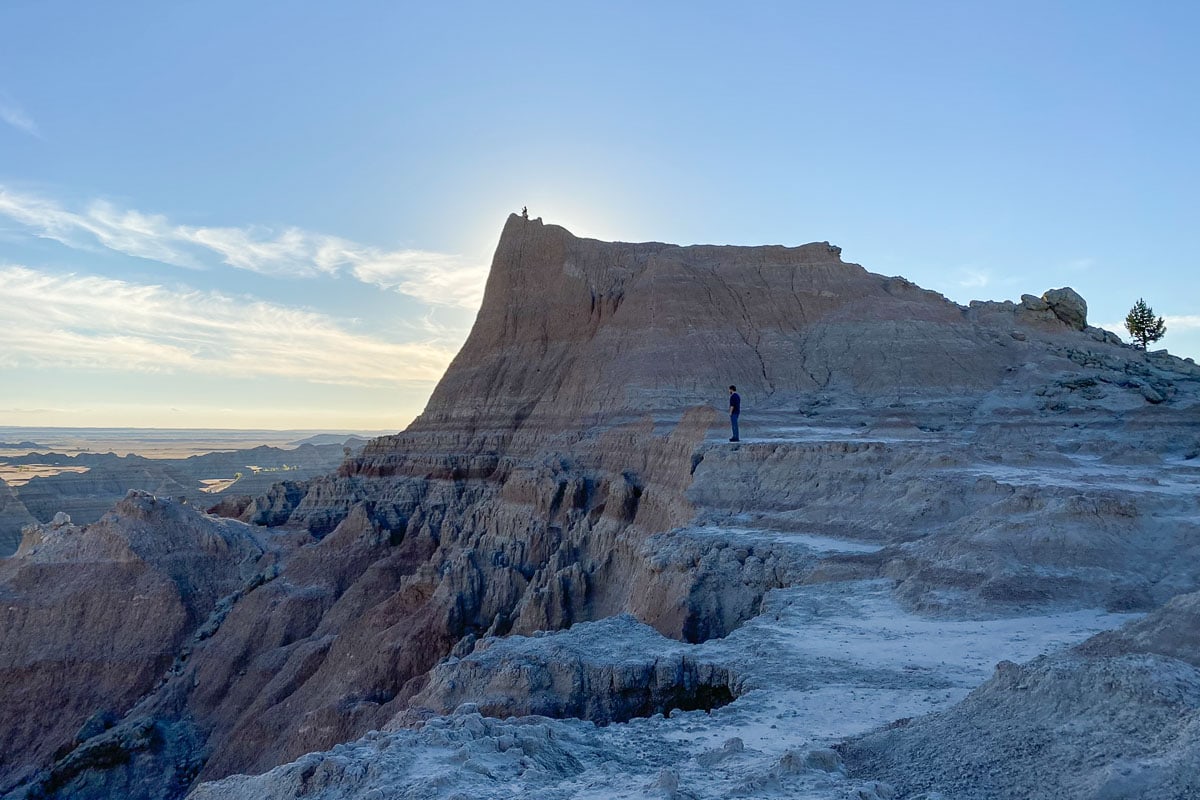
Without question the steepest trail in Badlands National Park, the Saddle Pass Trail climbs quickly from the Badlands Loop Road up to the top of the Badlands Wall.
The total elevation gain is approximately 300 feet, much of which is on a rather short, exceptionally steep section. Much of the trail surface is loose gravel, which makes it quite slippery in certain areas.
Once up on Saddle Pass, you can enjoy a breathtaking view of the White River Valley below. The ledge offers amazing photo ops, while you can also explore the upper Badlands area further on the connecting Castle and Medicine Root Trails.
During my visit to the park, hiking the Saddle Pass Trail was one of the most fun things I did in Badlands National Park.
9. Walk the Easy Door and Window Trails


The Door Trail leads to a great view of the Badlands in the eastern portion of the park.
As the name suggests, this trail takes you to an opening in the Badlands called “the Door” via an accessible boardwalk. Beyond the boardwalk, the trail continues but is unpaved and unmaintained.
This is a great trail to immerse yourself in the ruggedness of the Badlands and is especially spectacular just after sunrise.
The roundtrip distance of the Door Trail is only 0.75 miles. Its trailhead is at the expansive Door, Window, Notch and Castle Trail parking area, a short drive south of the popular Big Badlands Overlook.
The Window Trail, located just south of the Door Trail, is even shorter, with a total roundtrip distance of 0.25 miles.
The entire hike is on a boardwalk, leading to a natural window in the Badlands Wall, which offers a view of an eroded canyon. From “the Window,” you can clearly see the famed Badlands Wall, as well as the park’s renowned rock formations.
10. See the Remarkable Yellow Mounds
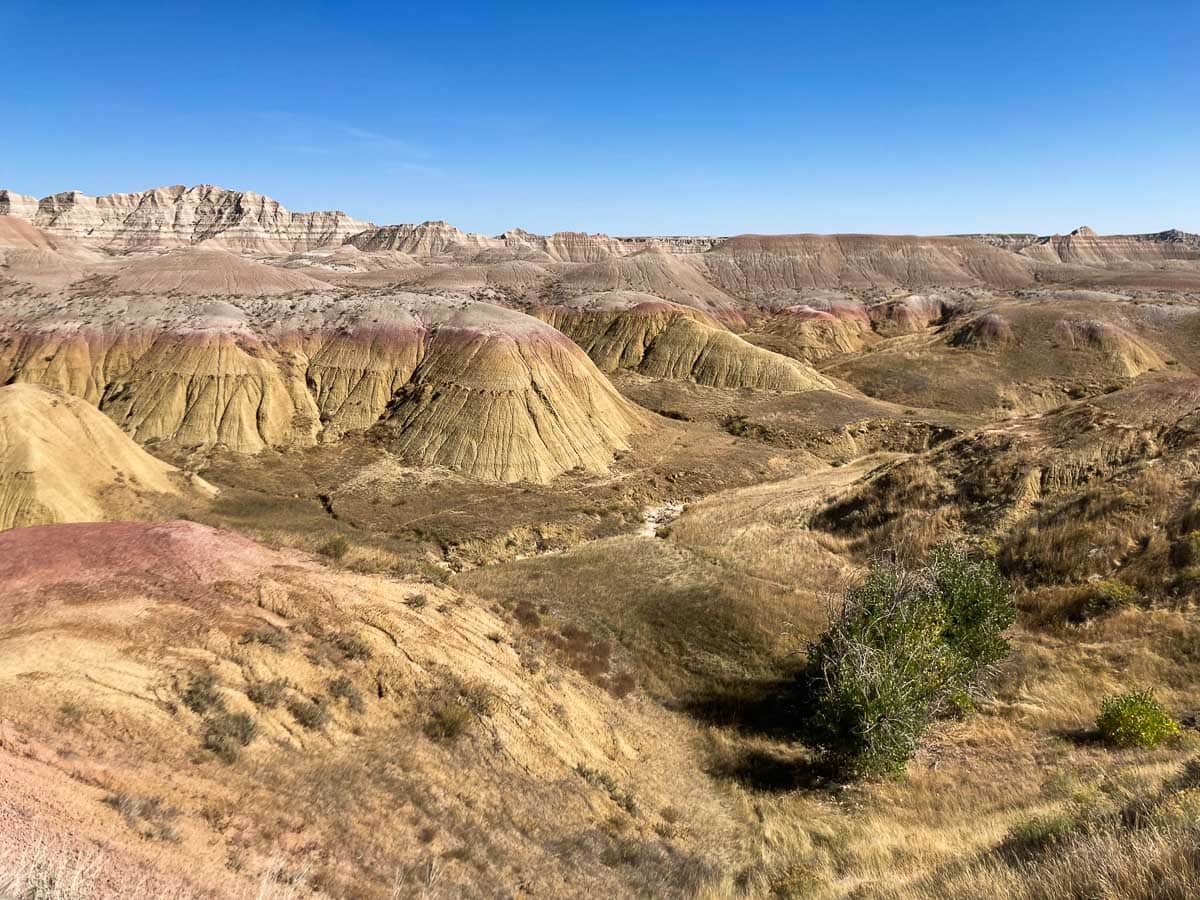
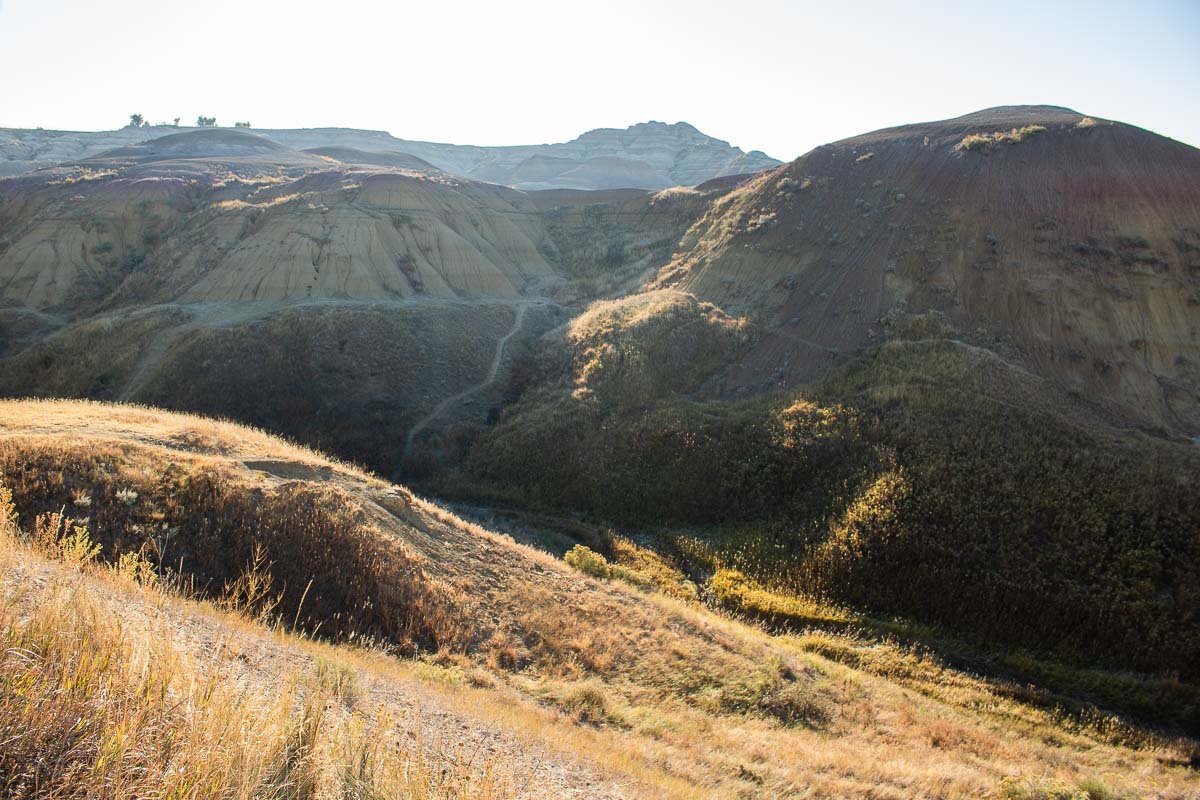
On the map of Badlands National Park they’re just another overlook, but in real life the Yellow Mounds are an extraordinary sight.
The Yellow Mounds Overlook is near the intersection of the Badlands Loop Road and Conata Road, within one of the park’s most colorful geological areas.
Park at the overlook and walk along the road for different vantage points. You can also wander into this remarkable landscape on social trails. Even climbing the mounds is allowed thanks to the park’s “open hike policy.”
The Yellow Mounds are so special because they offer an insight into some of the older rock formations of Badlands National Park.
From bottom to top, layers of yellow, gray and red each represent a distinct geological formation, respectively the Interior Paleosol, Chadron and Brule formations.
11. View Majestic Bison Grazing on the Prairie


Also (incorrectly) called buffalo, millions of American bison (Bison bison) used to roam the sprawling American prairie before getting perilously close to extinction in the late-19th century.
Although they’re now once again present in the Badlands, they did have to be reintroduced here from nearby Theodore Roosevelt National Park in 1963.
Luckily, Badlands National Park’s sprawling mixed-grass prairie has helped the bison population to recover.
The park is in the heart of the bison’s historic range, an ideal environment for them to continue thriving (albeit under careful management).
Nowadays, this is one of only a handful of national parks where you can see bison in their native habitat, making bison viewing one of the most popular things to do in Badlands National Park.
The Badlands National Park bison herd consists of approximately 1,200 animals, making it one of the largest federally managed bison herds in the nation.
They’re mainly found in the western part of the North Unit, especially in the grasslands and on the slopes along the Sage Creek Rim Road. You can usually also see bison near the Pinnacles Entrance Station on the western part of the Badlands Loop Road.
Find the best places to see bison in Badlands National Park here!
Bison are surprisingly fast and can be dangerous. Badlands National Park regulations require all visitors to stay at least 100 feet away from bison, as well as all other animals. Learn more about bison safety here.
12. Watch Bighorn Sheep


About 250 bighorn sheep (Ovis canadensis) currently call Badlands National Park home. These masters of the mountains are able to scale seemingly impossibly steep and rocky terrain, and are usually found on grassy slopes or in foothills below rocky cliffs and buttes.
This makes Badlands National Park, with its combination of rolling prairie, rugged ridges and sheer cliffs, the perfect bighorn sheep habitat.
These fascinating animals, named after the rams’ large, curved horns, live in (small) groups. It’s rare to see just one bighorn sheep. Usually when you see one, there are others nearby.
In Badlands National Park, the best places to see bighorn sheep are the Pinnacles Overlook, White River Valley Overlook, Big Badlands Overlook and Cedar Pass.
You might occasionally spot them elsewhere along the Badlands Loop Road, too. Additionally, the Old Northeast Road is also a good area for bighorn sheep watching.
13. Get Away From the Crowds on Conata Road and Buffalo Gap National Grassland
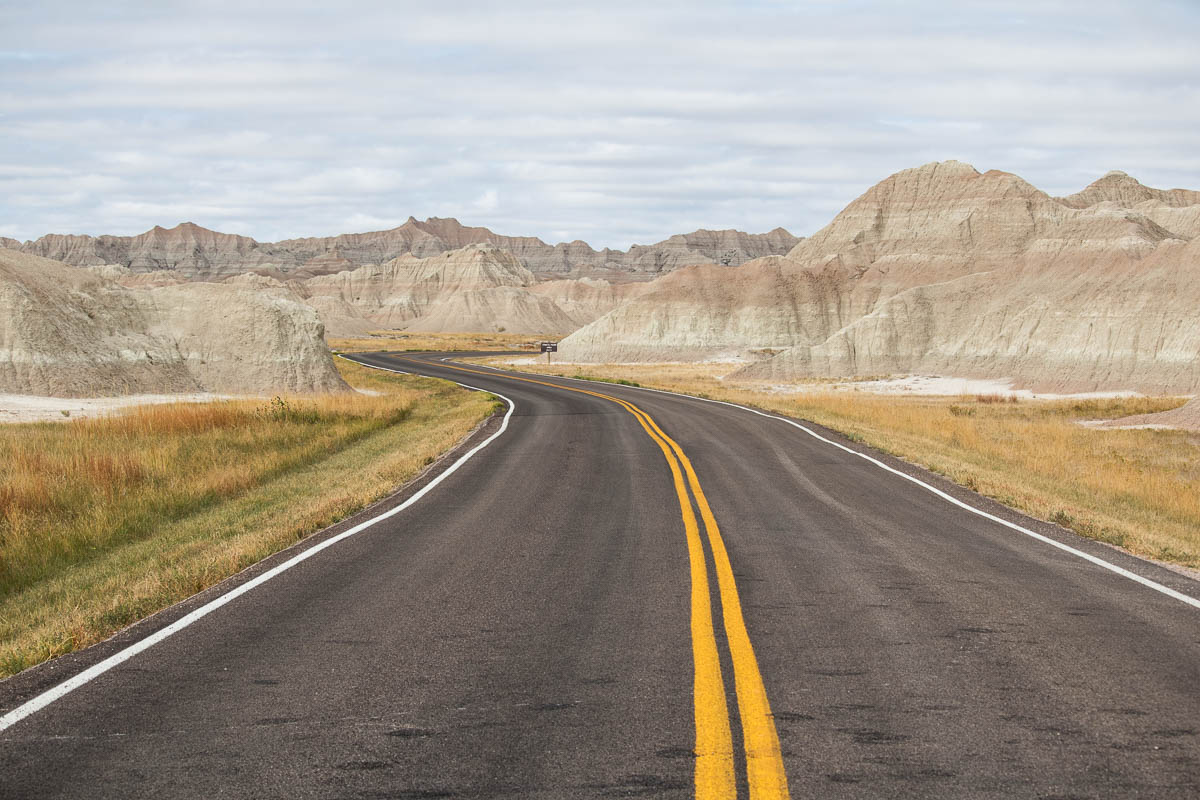
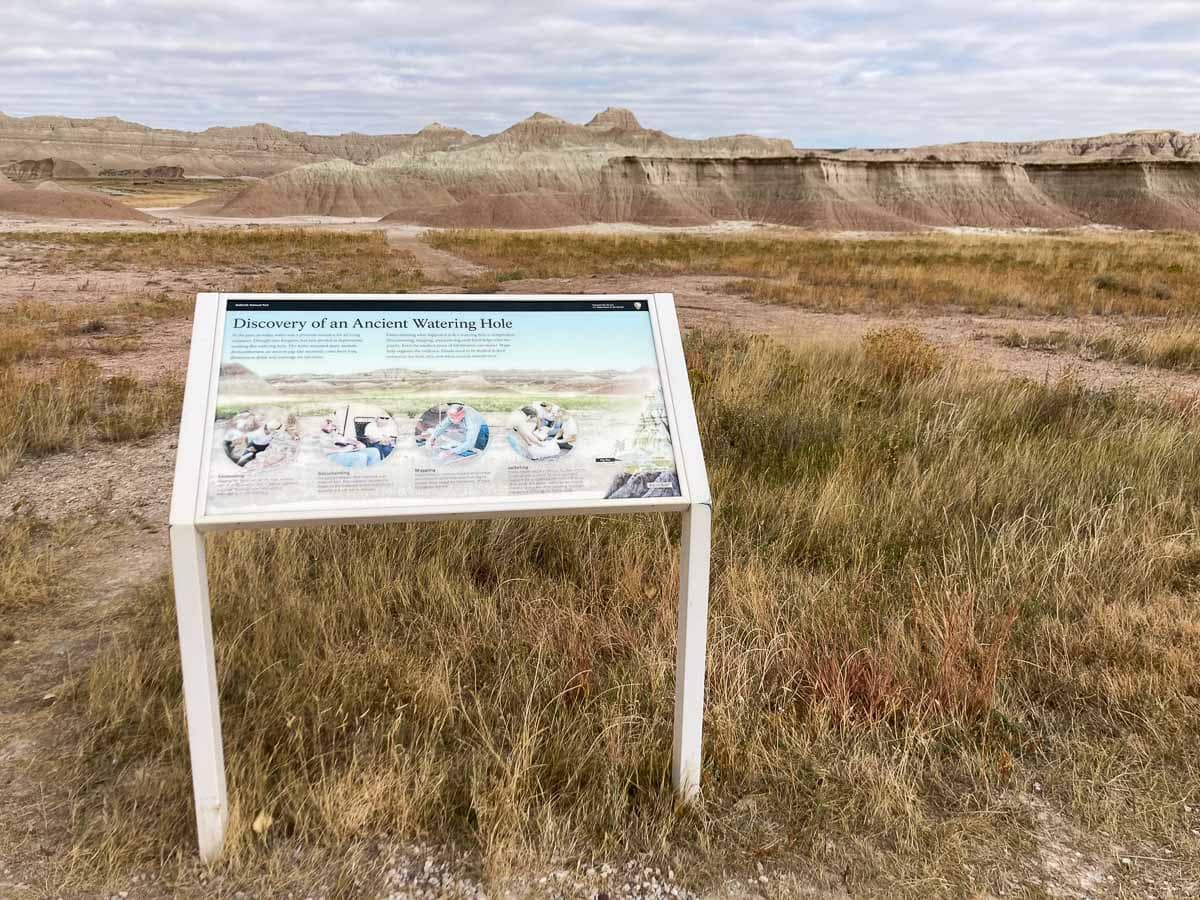
There are numerous gravel roads that lead from the Badlands Loop Road into the prairielands of Buffalo Gap National Grassland. Conata Road is one of the “bigger” of those roads.
Starting off as a paved road running south into the Conata Basin from the Loop Road, it quickly turns into gravel as you enter Buffalo Gap National Grassland. This vast area of mixed-grass prairie that surrounds most of Badlands National Park is managed by the U.S. Forest Service.
Conata Road is one of the quieter areas in and around Badlands National Park. This makes it a great place to see wildlife like prairie dogs, pronghorn and mule deer. Bison are occasionally seen here as well.
The section of Conata Road within Badlands National Park has a couple of fun attractions.
There’s the relatively remote Conata Picnic Area, equipped with covered picnic benches and pit toilets. The west side of the picnic area’s parking lot offers access to the Deer Haven Wilderness Trail, which is basically a collection of unofficial game trails.
Just down the road from the picnic area, you’ll find the site of the so-called Big Pig Dig, where fossils were excavated during a 15-year period.
14. Find Your Favorite Badlands National Park Overlook
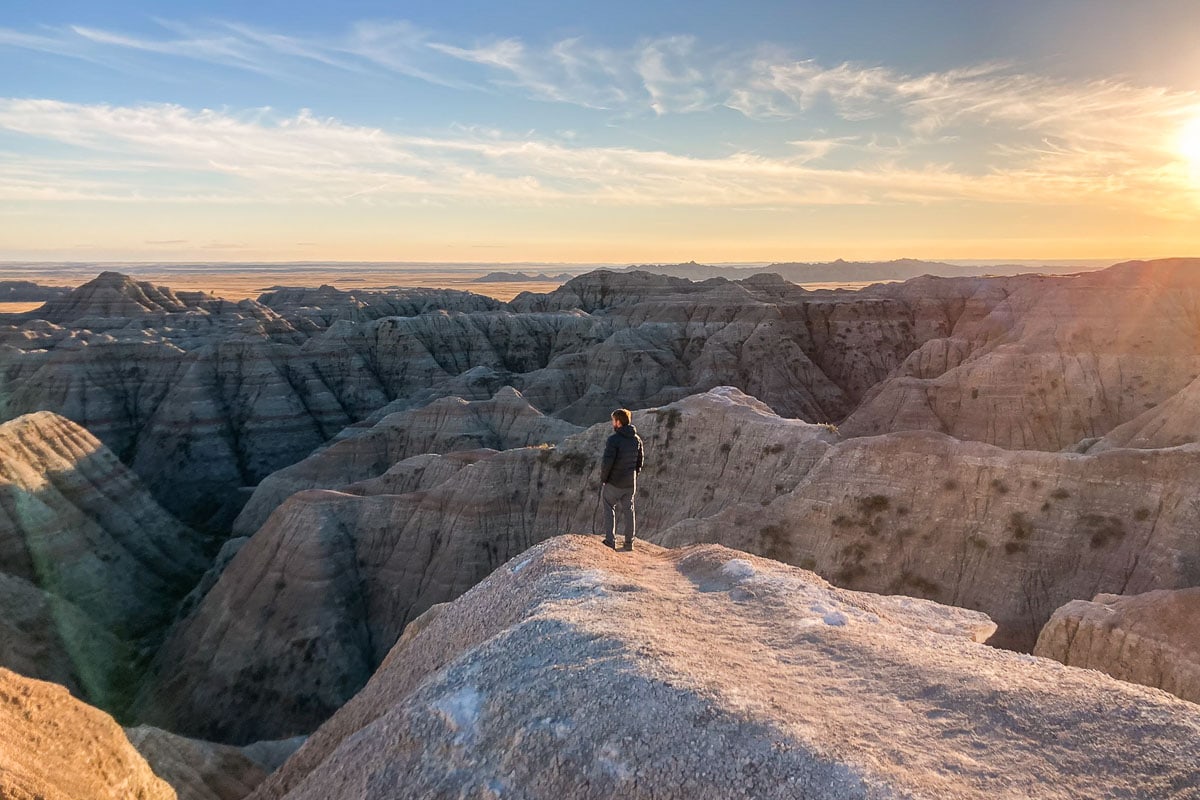
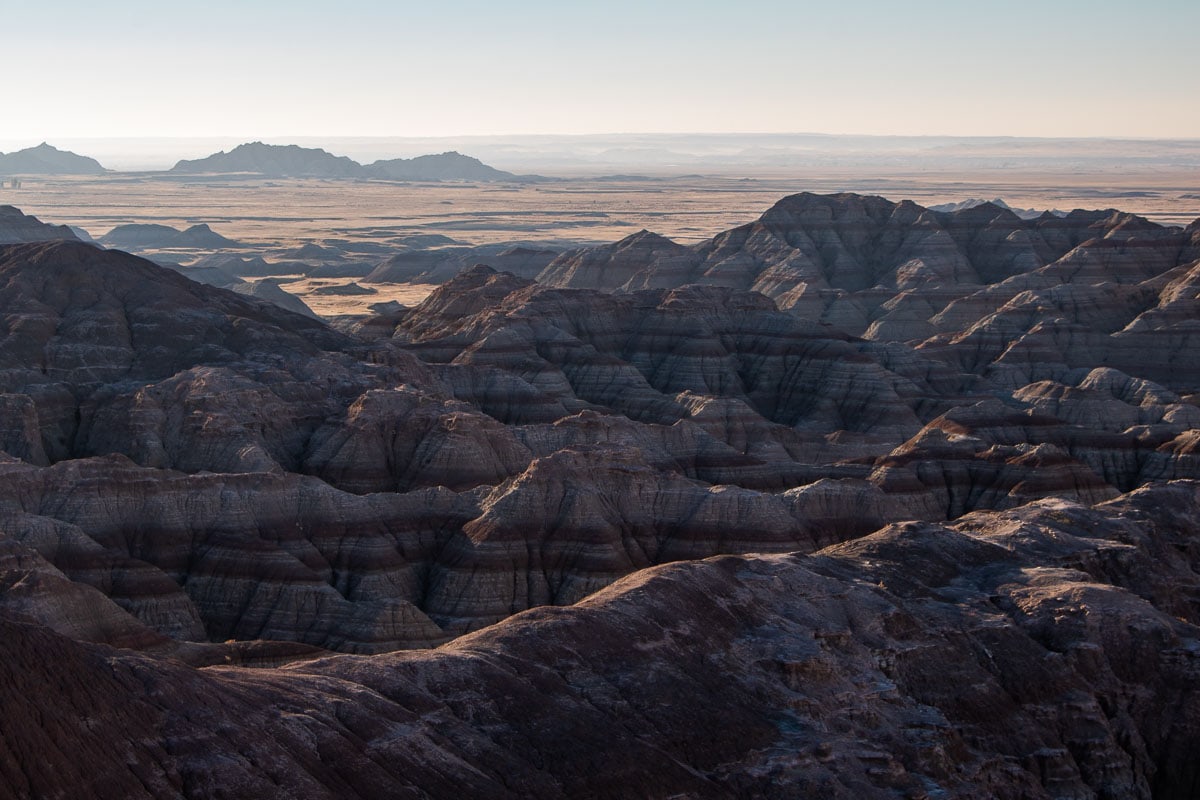
There are more than ten scenic overlooks on the Badlands Loop Road and a few more on the Sage Creek Rim Road. If you want a spectacular panorama of the Badlands, those roads are where you’ll find them.
If you have sufficient time, I suggest stopping at all overlooks. Each one has a different vantage point and views, whether it’s toward the lower prairie or upper prairie, which are separated by the Badlands Wall.
Some overlooks take in the vast prairie landscape, while others provide a sensational Badlands vista. If you don’t have a lot of time and must pick and choose, the following are the Badlands Loop Road overlooks I don’t want you to miss. They’re among the greatest attractions in Badlands National Park.
- Big Badlands Overlook
- White River Valley Overlook
- Panorama Point
- Burns Basin Overlook
- Yellow Mounds Overlook
- Pinnacles Overlook
Additionally, the overlooks on the Sage Creek Rim Road are phenomenal as well. Don’t skip them!
- Hay Butte Overlook
- Badlands Wilderness Overlook
- Sage Creek Basin Overlook
You can see a complete overview of ALL overlooks in Badlands National Park here!
15. Drive the Sage Creek Rim Road


Sage Creek Rim Road is a gravel road that runs through the northwest portion of Badlands National Park’s North Unit. It starts off of the Badlands Loop Road just south of the Pinnacles Entrance.
While many visitors skip this scenic drive due to a lack of time, this is definitely a part of the park that deserves to be explored.
The dirt road offers great views of the vast Sage Creek Wilderness Area, a landscape of rolling grass-covered hills, dotted with small badlands and wooded areas. The primitive Sage Creek Campground has 22 campsites and makes for a nice basecamp to explore the wilderness.
As mentioned above, there are a few scenic viewpoints along this road, too, namely the Hay Butte, Badlands Wilderness and Sage Creek Basin overlooks. Roberts Prairie Dog Town is another popular attraction.
And in addition to prairie dogs, Sage Creek Rim Road is arguably the best place in Badlands National Park to see bison. I also saw a coyote and a herd of pronghorn here.
If you’re visiting Badlands National Park with your dog, the Sage Creek Rim Road is a fantastic place to go for a walk!
16. Watch Prairie Dogs in Their Towns
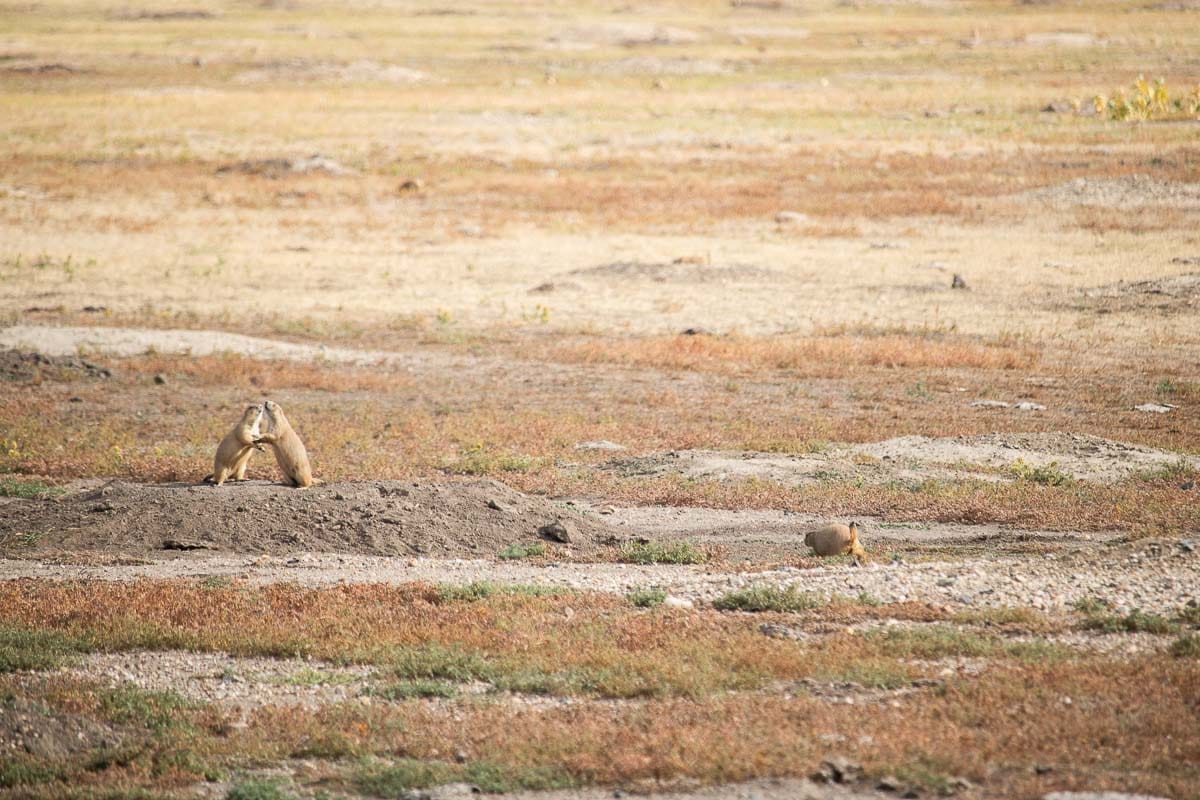
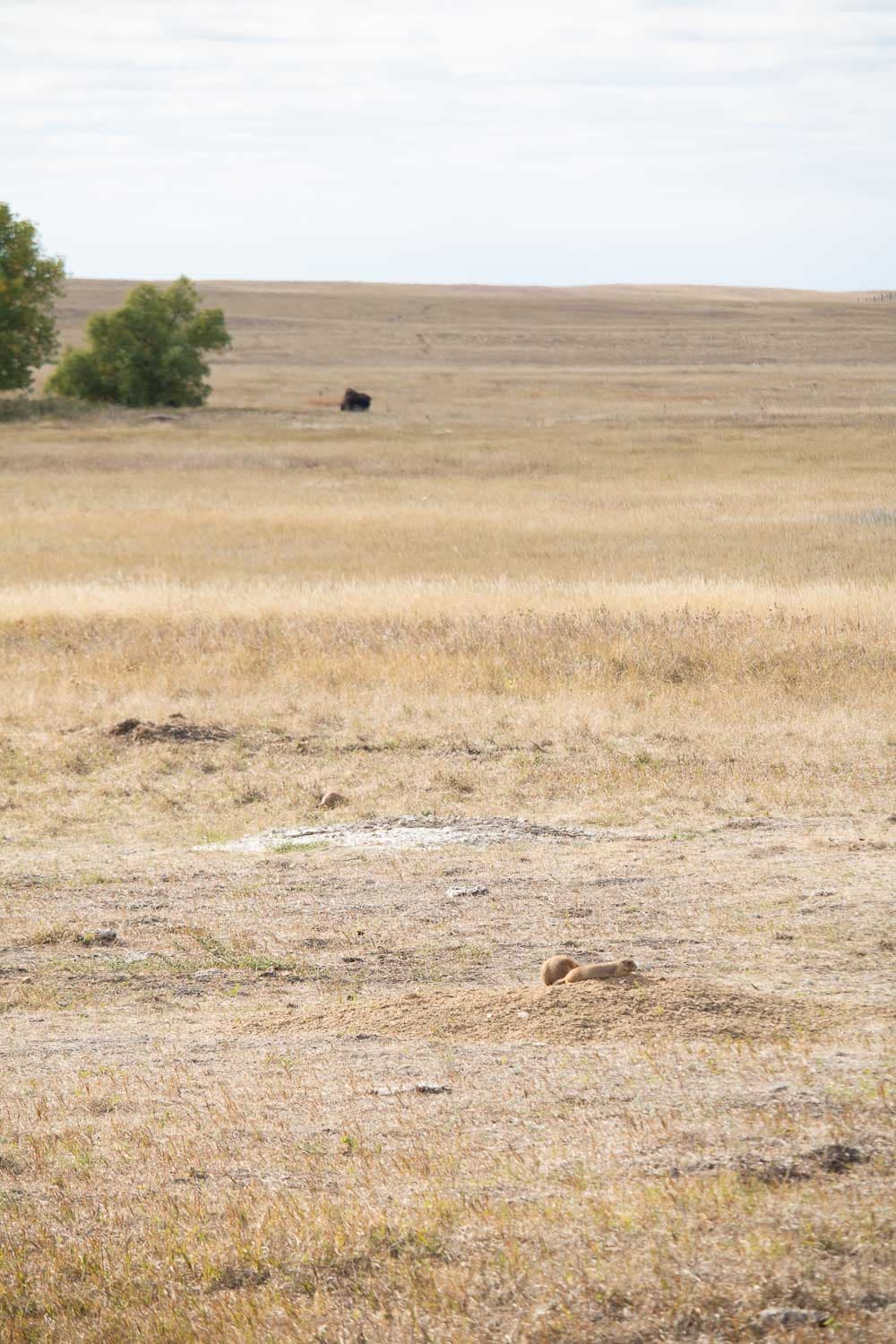
One of the most popular things to do in Badlands National Park is watching its resident black-tailed prairie dogs (Cynomys ludovicianus) go about their daily lives.
These industrious little creatures, which are related to chipmunks and squirrels, live in underground colonies called “towns.”
Prairie dog towns are exceptionally complex, made up of numerous entrances, passageways, food storage rooms and side chambers. These towns are divided into distinct units known as “coteries,” which are essentially neighborhoods. Each coterie encompasses approximately one acre and has 50 to 60 entrance and exit points.
Prairie dog towns can be truly enormous, often encompassing dozens of square miles. According to the National Park Service, the largest prairie dog town ever recorded was 25,000 square miles in size!
There are several prairie dog towns in Badlands National Park. Some of the best places to see these animals in Badlands are Sage Creek Campground, the Burns Basin Overlook, the Pinnacles Entrance Station and, of course, Roberts Prairie Dog Town on the Sage Creek Rim Road.
17. Explore Remote Badlands Wilderness Areas
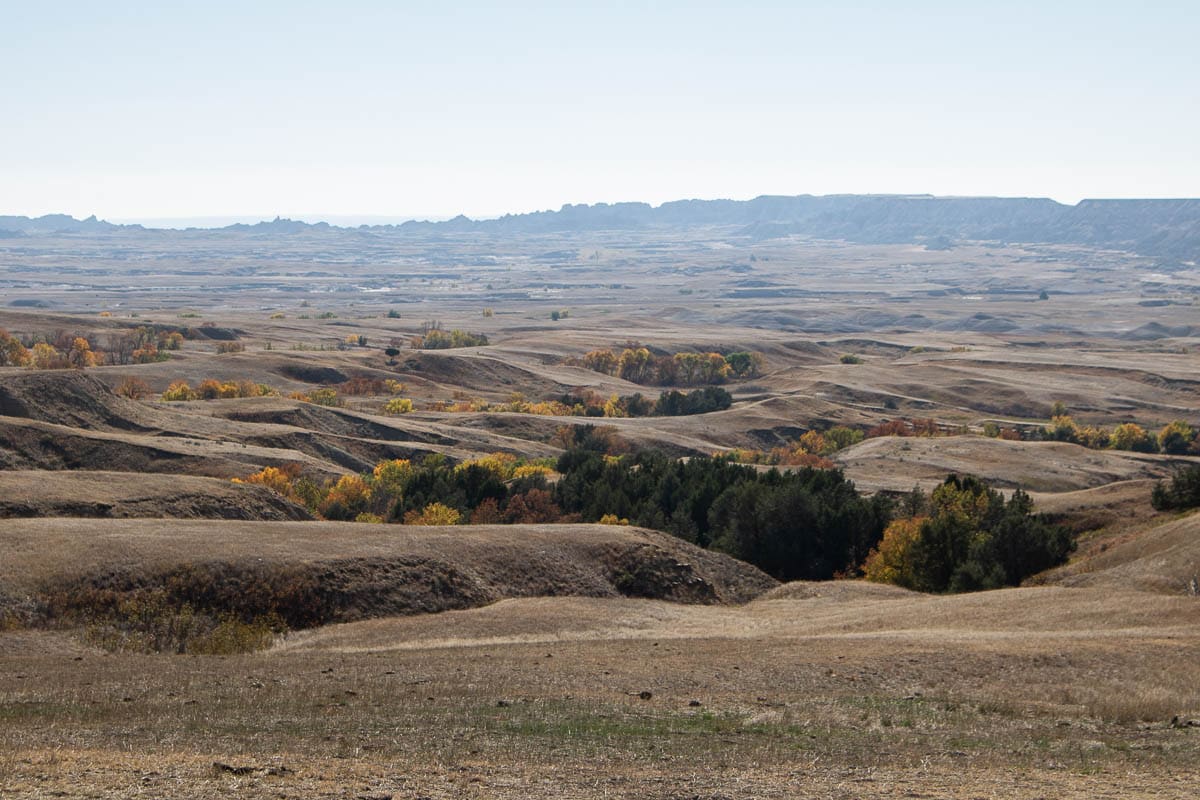

Badlands National Park is one of a few national parks that have an “open hike policy.” This means that you are allowed to leave the trails and, essentially, wander around as you please.
Visitors are “free to explore social trails like Deer Haven, the Sage Creek Wilderness Area or any other part of the park you can visit safely,” the National Park Service says.
You can climb Badlands formations, follow game trails into the backcountry and meander through the prairie grasslands as far and as long as you want.
For an unforgettable wilderness experience in the Badlands, I recommend heading into the Sage Creek Wilderness backcountry. You can explore this area on a long day hike or spend a night or two camping in the wilderness.
You can enter the Sage Creek Wilderness from various locations along the road, but the best ones are the Sage Creek Campground and the Sage Creek Basin Overlook. Make sure to enter your information in the backcountry register before your hike.
This area is different from other places in Badlands National Park, in the sense that it consists of mostly eroded-away Badlands. The Cretaceous sediments below the Badlands rock layers are “more suitable for soil development for the grasslands,” according to the National Park Service.
As such, prairie grasslands dominate this area, crisscrossed by bison trails. You can clearly see these game trails from the road and you’re free to explore the wilderness on these trails.
Keep an eye out for bison and other wildlife, though. Many animal species, some dangerous, live in the Sage Creek Wilderness. Additionally, the weather can change suddenly and cell service is usually not available in the backcountry.
18. Drive Around the Stronghold Unit

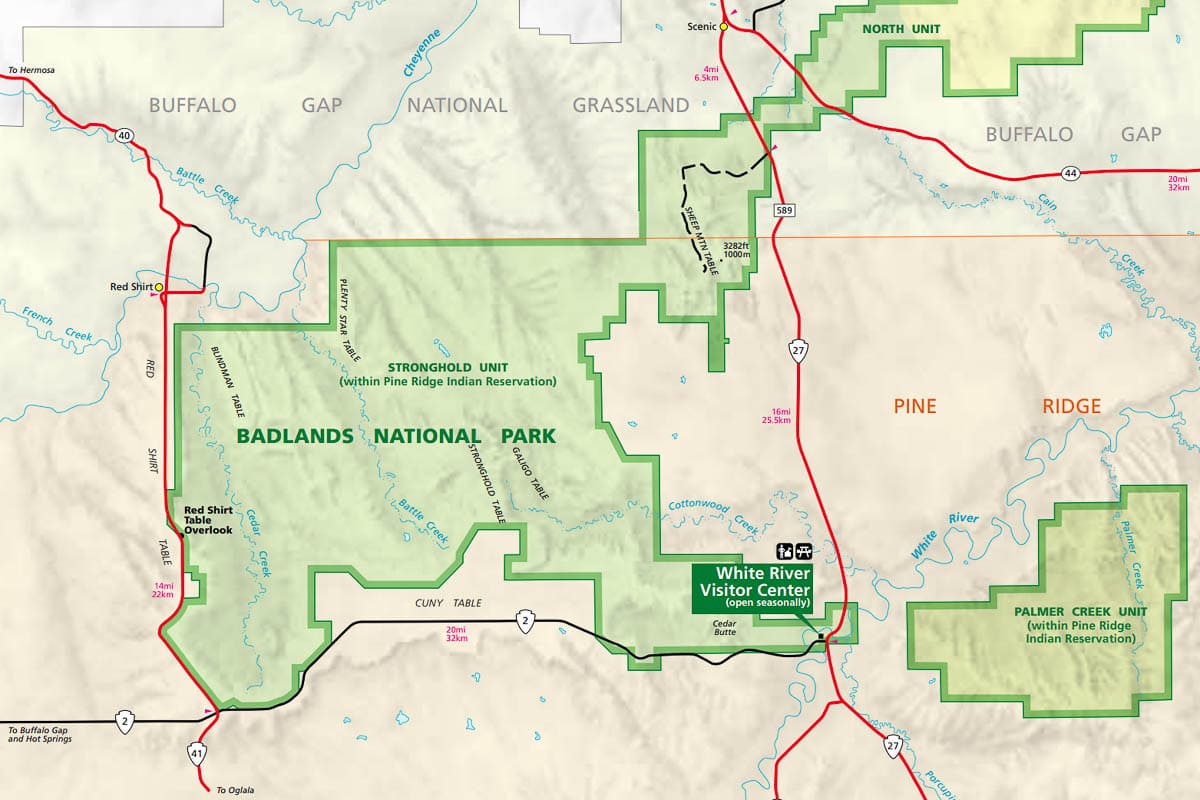
While all other things to do in Badlands National Park I talked about above are in the North Unit, the park also comprises a South Unit, which is equally as large and spectacular. Except for the rugged Sheep Mountain Table Road, there are no roads through this unit, but you can drive around it.
Also known as the Stronghold Unit, this park unit sits within the Pine Ridge Reservation owned by the Oglala Sioux Tribe. The National Park Service and the Tribe co-manage the unit.
At the end of the 19th century, Stronghold Table was the site of the last Ghost Dance of the Lakota.
Up until today, both the Stronghold and Sheep Mountain Table—the only area in the South Unit accessible to visitors—are “favorite sites for young Lakota men to go to fast and pray, hoping to have a vision for their future,” the National Park Service says.
The drive around the Stronghold Unit starts in Scenic, just west of the southern end of the Sage Creek Road. It runs around the eastern, southern and western boundary of the Strongold Unit in a clockwise direction, ending in the small community of Red Shirt. It’s a one-hour drive one-way.
There are a couple of places worth stopping at. Don’t skip the White River Visitor Center (if it’s open) and the amazing Red Shirt Table Overlook.
The Stronghold Unit Is a Sacred Place, Be Respectful
The National Park Service reminds visitors that “as you travel on Pine Ridge Reservation, particularly on the South Unit of Badlands National Park, you may find signs of religious worship.”
“These could take the shape of prayer sticks or small bundles tied to branches. It could be simply a piece of brightly colored fabric tied to a shrub. These are signs of traditional worship by Tribal members. Please respect their beliefs and practices and leave these objects.”
19. Visit Wall Drug
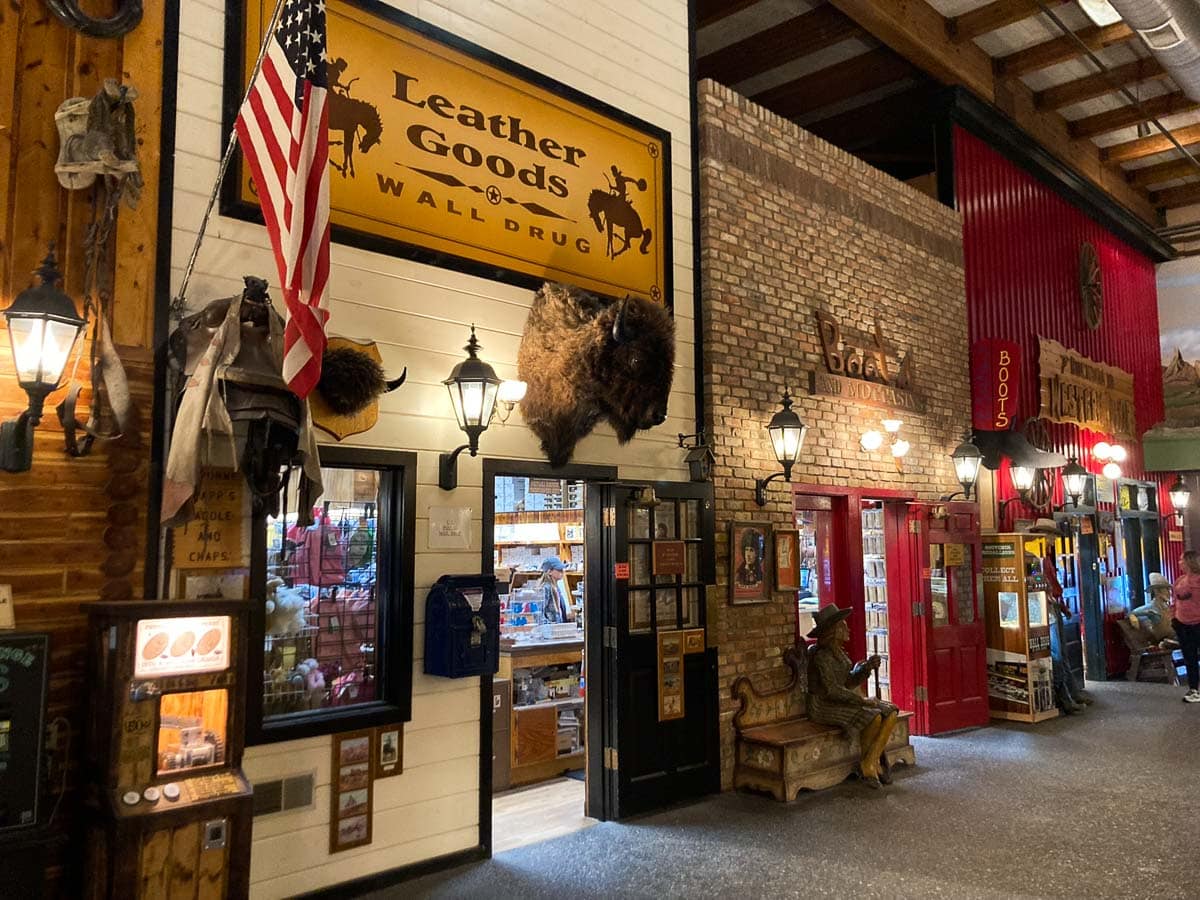

Although this isn’t technically one of the things to do within Badlands National Park, a visit to the park isn’t complete without exploring Wall Drug.
When you drive toward Badlands on I-90 from either direction, you’ll see signs for this almost-legendary roadside stop from dozens, if not hundreds, of miles away.
It is located in its namesake town of Wall, South Dakota, just north of Badlands National Park.
Its humble origins dating back to the 1930s, Wall Drug has become nothing less than a phenomenon. It now attracts more than two millions visitors each year to what once was called “the geographical center of nowhere.”
This iconic complex of Western-and-cowboy-themed shops comprises an actual drug store, camping and outdoor outfitters, cowboy clothing stores, and the Western Art Galley Restaurant that serves Wall Drug’s famous 5-cent coffee among many other menu items.
Additionally, Wall Drug is home to a truly impressive number of souvenir shops of all kinds. There’s a Black Hills Gold jewelry store, the Hole in the Wall Bookstore, Calamity Jane’s Jewelry Emporium, the Mining Company Rock Shop, Shooting Gallery Arcade and the Apothecary Shop.
Even despite its kitschy décor and generic products, Wall Drug is an unmissable destination when visiting Badlands National Park. It’s an experience in its own right.
If you’re not camping in the park, I personally recommend staying in the town of Wall. Consider booking a night or two at the Badlands Frontier Cabins, just south of the Wall town center and only 7-8 minutes by car from Badlands National Park’s Pinnacles Entrance.

